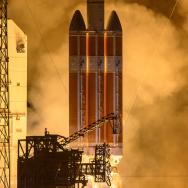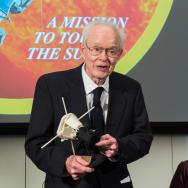Prof. Eugene Parker had never seen a NASA launch in person until Aug. 12, 2018—when a spacecraft honoring the pioneering University of Chicago astrophysicist blazed through the predawn skies, beginning its ambitious mission to the sun.
Six decades after Parker wrote a groundbreaking paper that shaped how we view the solar system, the launch of Parker Solar Probe was not only historic but also emotional for the 92-year-old scientist.
“So much has gone into this launch, and then to see it all disappear slowly—fading away into the night sky, knowing it will never come back—it was a moving experience,” Parker said.
In the year since, Parker has been receiving updates on the NASA mission, which has already come closer to the sun than any spacecraft. Parker recently visited with Nicky Fox, director of NASA’s Heliophysics Division at NASA Headquarters in Washington, at his Hyde Park apartment and learned that the spacecraft is running perfectly—and has gathered twice as much data as originally predicted.
“Parker Solar Probe is blazing a trail as she orbits through the corona; she’s behaving beautifully,” said Fox. “We’re actually very excited because we have more than twice as much data as we had expected.”
Parker Solar Probe has circled the sun twice thus far, and on Sept. 1 will reach its closest point to the star yet.
“It’s pretty exciting stuff,” said Parker, who is the only living person to have a NASA mission named after them.
The spacecraft, built by Johns Hopkins Applied Physics Laboratory to withstand the intense heat and radiation coming off the sun, is a marvel of engineering. It is the fastest-moving object built by humans, traveling at more than 150,000 miles per hour. It must constantly orient itself to keep its shield—a four-and-a-half inch-thick slab of carbon composite that can withstand the 2,500-degree Fahrenheit temperatures—between itself and the star. (Except for one especially tough instrument, built by UChicago alum Justin Kasper, which peeks around the edge of the craft to scoop up particles of the solar wind).
A simulation of Parker Solar Probe’s orbit around the sun.
‘Fascinating every step of the way’
Parker Solar Probe will come closer than any other spacecraft to the sun, seeking to understand multiple mysteries about our star—such as why the corona around the sun is actually hotter than the surface of the sun itself.
“You rarely have a space mission that doesn’t come up with the unexpected, and it’s actually going to get more exciting as the mission goes on and crosses into regions that spacecraft have never been in before,” Parker said. “It’s just fascinating every step of the way.”
These questions have their origins in a revolutionary 1958 paper authored by Parker, which claimed that the sun was expelling waves of particles in every direction. Though the idea was roundly rejected by the scientific community at first, we now know this phenomenon, which Parker called the solar wind, shapes the entire solar system.
“A lot of people don’t realize that space is not just empty space—it’s full of this constantly active plasma that is carrying the magnetic field from the sun towards us and forming a protective bubble around the solar system,” Fox said. “When something happens on the sun, we feel the impact here on Earth, and it was all predicted by Eugene Parker.”
Scientists also hope to use Parker Solar Probe’s observations to better predict solar flares and to understand how to protect future astronauts traveling through space who would encounter solar radiation.
Early answers may lie in the 22 gigabytes of data Parker Solar Probe collected during its first two encounters with the sun, but as Parker said: “I wouldn’t be surprised if the most surprising things have yet to come.”

